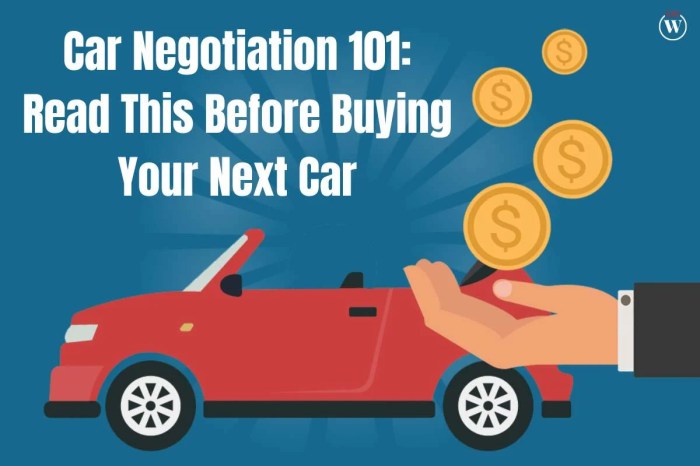How to Get Price Down on New Car
Negotiating with Dealerships
How to get price down on new car – Successfully negotiating a lower price on a new car requires preparation, strategy, and confidence. This section details a step-by-step approach to navigating the negotiation process with car dealerships.
Preparing for Negotiations, How to get price down on new car
Before stepping onto the dealership lot, thorough preparation is key. This includes researching the car’s market value using online resources like Kelley Blue Book (KBB) and Edmunds. Knowing the fair market price empowers you to make informed decisions and prevents being swayed by inflated dealer prices. Determine your budget and maximum acceptable price beforehand. This prevents emotional overspending during negotiations.
- Research the car’s market value using online resources like Kelley Blue Book (KBB) and Edmunds.
- Determine your budget and maximum acceptable price.
- Gather information on available financing options and incentives.
- Practice your negotiation skills, role-playing potential scenarios.
Effective Communication Strategies
Communicate your desired price and budget clearly and confidently. Avoid revealing your maximum budget upfront. Instead, focus on your target price and highlight the value you’re seeking. Be prepared to walk away if the dealer is unwilling to meet your terms. This shows your seriousness and can often lead to a better offer.
Sample Negotiation Script
Here’s a sample negotiation script, illustrating potential responses from the dealer:
You: “Based on my research, I’m targeting a price of [your target price]. I’m prepared to negotiate, but this is my starting point.”
Dealer: “That’s below our invoice price. We can’t go that low.”
You: “I understand, but I’ve seen similar vehicles offered at a lower price. What can you offer to make this deal work for me?”
Dealer: “Let’s discuss financing options and potential rebates.”
You: “I’ve already pre-approved financing at [your interest rate]. Let’s focus on the vehicle price.”
Identifying and Leveraging Dealer Weaknesses
Dealerships often face pressure to meet sales quotas. End-of-month or end-of-quarter periods are opportune times to negotiate, as dealers are more motivated to close deals. Also, understanding the difference between MSRP, invoice price, and dealer cost can provide leverage during negotiations. Knowing the dealer’s cost gives you a realistic lower bound for your negotiations.
Comparison of Negotiation Tactics
| Tactic | Advantages | Disadvantages | Success Rate (estimated) |
|---|---|---|---|
| Walking away | Often results in a better offer | Requires confidence and willingness to walk away | 60-70% |
| Focusing on out-the-door price | Avoids haggling over individual items | May miss opportunities for additional savings | 50-60% |
| Using competing offers | Provides leverage | Requires obtaining actual offers from other dealerships | 70-80% |
| Negotiating add-ons separately | Allows for targeted price reduction | Can be time-consuming | 40-50% |
Timing Your Purchase
The timing of your car purchase significantly impacts the deals available. Understanding seasonal trends and dealer pressures can lead to substantial savings.
Optimal Times to Buy
Generally, the end of the month, quarter, and year are ideal times to buy a new car. Dealerships often have quotas to meet, making them more willing to negotiate during these periods. Additionally, the time of year influences inventory levels and demand, creating opportunities for better deals. For example, during slower sales periods (typically winter months in some regions), dealers may be more willing to negotiate to move inventory.
Impact of Seasonal Sales and Inventory
Seasonal sales events, such as year-end clearance sales, offer attractive incentives. Low inventory periods, often during peak demand times, can sometimes lead to less negotiation room, while high inventory periods might allow for more aggressive negotiation. Economic conditions and interest rates also influence pricing. During economic downturns, dealers may offer more attractive deals to stimulate sales.
End-of-Month/Quarter Deadlines
Dealerships often face pressure to meet sales targets at the end of each month and quarter. This pressure can translate into a greater willingness to negotiate prices and offer additional incentives to close deals before the deadline. Many salespersons will have quotas that must be met within a specified time frame, and they are often more willing to compromise during these periods.
Economic and Interest Rate Factors
Economic factors, such as inflation and consumer confidence, affect demand and pricing. High interest rates can reduce affordability and subsequently impact prices. Conversely, lower interest rates might lead to increased demand and potentially higher prices. It’s important to monitor these macroeconomic factors to understand their influence on the car market.
Tips for Strategic Timing
- Buy at the end of the month, quarter, or year.
- Take advantage of seasonal sales events.
- Monitor inventory levels and economic conditions.
- Be flexible with your timeline if possible.
- Consider waiting for model year changes to secure discounts on older models.
Financing and Incentives
Financing and incentives play a crucial role in the overall cost of a new car. Understanding the available options and their implications is vital for securing the best deal.
Comparing Financing Options
Several financing options exist, including dealer financing, bank loans, and credit unions. Each option offers varying interest rates, loan terms, and monthly payments. Pre-approval for financing strengthens your negotiating position, allowing you to focus on the vehicle price rather than haggling over financing terms. This shows the dealer you are a serious buyer and have secured your funding.
Leasing vs. Buying
Leasing offers lower monthly payments but results in no vehicle ownership at the end of the lease term. Buying provides ownership but involves higher monthly payments and depreciation. The best option depends on individual needs and financial circumstances. Consider factors like mileage limits, wear-and-tear charges, and potential penalties for early termination when choosing between leasing and buying.
Securing Pre-Approval
Pre-approval for financing provides a clear picture of your borrowing power and helps you negotiate more effectively. It allows you to focus on the vehicle price, knowing your financing is already secured. It also demonstrates your seriousness as a buyer to the dealership.
Manufacturer Rebates and Incentives
Many manufacturers offer rebates, incentives, and loyalty programs to attract buyers. These incentives can significantly reduce the overall cost of the vehicle. It’s crucial to research and understand the available incentives before starting negotiations. Often, these incentives are advertised online or through the dealership.
Comparison of Financing Options
| Option | Interest Rate (Example) | Loan Term (Example) | Monthly Payment (Example) |
|---|---|---|---|
| Dealer Financing | 5% | 60 months | $400 |
| Bank Loan | 4.5% | 72 months | $350 |
| Credit Union Loan | 4% | 48 months | $450 |
Exploring Alternative Purchase Methods
Buying a new car isn’t limited to dealerships. Exploring alternative methods, such as purchasing from private sellers or online marketplaces, can offer different advantages and disadvantages.
Dealership vs. Private Seller

Source: ciowomenmagazine.com
Dealerships offer warranties, financing options, and a more structured buying process, but often come with higher prices. Private sellers usually offer lower prices but lack warranties and financing options, requiring more due diligence on the buyer’s part. The buyer should always verify the vehicle’s history report to avoid potential issues.
Finding Deals from Private Sellers

Source: com.au
Finding deals from private sellers requires actively searching online marketplaces and classified ads. Thoroughly inspect the vehicle, verify its history report, and negotiate the price and terms carefully. Always bring a trusted mechanic to inspect the vehicle before finalizing the purchase.
Negotiating with Private Sellers
Negotiating with private sellers often involves a more direct and informal process than with dealerships. Research the market value of the vehicle to determine a fair price. Be prepared to walk away if the seller is unwilling to negotiate reasonably.
Comparing Overall Costs
The overall cost of a new car varies depending on the source. Dealerships typically have higher prices but offer financing and warranties. Private sellers usually offer lower prices but require more effort in due diligence and financing.
Flowchart for Buying from a Private Seller
A flowchart illustrating the steps would visually represent the process, starting with finding a vehicle, followed by inspecting it (potentially with a mechanic), obtaining a vehicle history report, negotiating the price, completing the paperwork, and finally, transferring ownership. Each step would be represented by a box, with arrows indicating the flow of the process.
Understanding Car Pricing: How To Get Price Down On New Car
The sticker price of a new car is just the starting point of the negotiation. Understanding the components of the price and the difference between MSRP, invoice price, and dealer cost is crucial for effective negotiation.
Components of Sticker Price
The sticker price, or MSRP (Manufacturer’s Suggested Retail Price), includes the base price of the vehicle, destination charges, and any optional equipment or packages. However, it does not typically include dealer fees, taxes, or financing charges. These additional costs are added later in the sales process.
MSRP, Invoice Price, and Dealer Cost
MSRP is the suggested retail price set by the manufacturer. The invoice price is the price the dealer pays the manufacturer for the vehicle. The dealer’s cost is typically lower than the invoice price and includes any additional incentives or discounts the dealer may receive. Knowing the invoice price or even better, the dealer’s cost, gives you a strong negotiating position.
Researching Market Value
Online resources like Kelley Blue Book (KBB) and Edmunds provide tools to research the true market value of specific car models and trim levels. These resources consider factors like vehicle condition, mileage, and options to provide a fair market price estimate.
Negotiating Dealer Add-ons and Fees
Dealers often try to add extra fees and charges, such as extended warranties, paint protection, or fabric protection. These add-ons can significantly increase the final price. It is important to carefully review all add-ons and fees and negotiate their removal or reduction. Many are unnecessary and overpriced.
Visual Representation of Price Breakdown
A detailed illustration would show a breakdown of the car’s price, starting with the MSRP, then subtracting any rebates or incentives. Next, it would add the destination charge and the cost of any optional equipment. Finally, it would add dealer fees, taxes, and financing charges to arrive at the final out-the-door price. The visual representation would clearly show the impact of each component on the total cost, highlighting areas where negotiation is possible.
Clarifying Questions
What is the best day of the week to buy a car?
The end of the month or quarter is generally considered the best time, as dealers are often more motivated to close deals to meet sales quotas. Weekdays are usually better than weekends due to less customer traffic.
How much should I offer below the sticker price?
A good starting point is typically 10-15% below the sticker price, but research the market value of the car to determine a more precise offer. Be prepared to walk away if the dealer is unwilling to negotiate reasonably.
Negotiating a lower price on a new car often involves understanding the car’s true value. To effectively negotiate, you first need to know what a fair price is, which is where learning how to calculate new car price comes in; check out this helpful guide on how to calculate new car price to get started. Armed with this knowledge, you can confidently approach dealerships and aim for a price that aligns with your calculated value, maximizing your savings.
What documents should I bring to the dealership?
Bring your driver’s license, insurance information, pre-approval letter for financing (if applicable), and any trade-in documentation. Having these ready streamlines the process.
Can I negotiate the interest rate on my car loan?
Yes, you can. Shop around for financing from multiple lenders before heading to the dealership to secure the best interest rate possible. Having pre-approval strengthens your negotiating position.





















